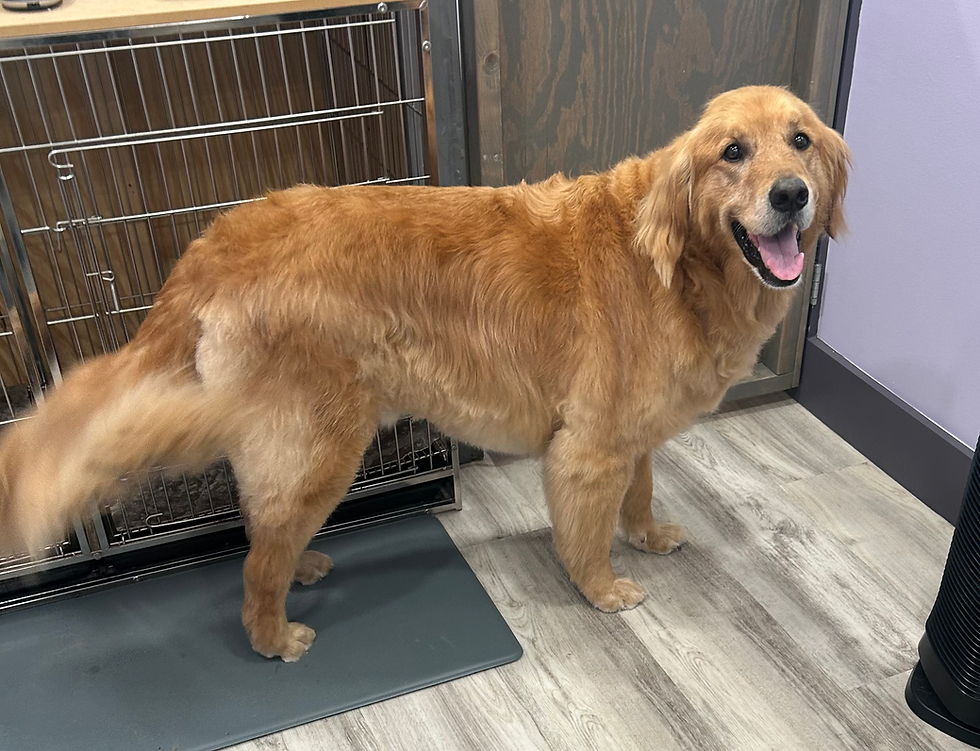Why Regular De-Shedding is Essential for Your Dog — Especially in the Texas Heat
- Petopia
- Aug 11
- 4 min read
Updated: Aug 14



When you live in Texas, you know the summer can be brutal. While we’re looking for shade and air conditioning, our dogs rely on their coats to regulate their temperature — and for breeds with thick, double coats like Golden Retrievers and Pomeranians, that means shedding season is serious business.
At Petopia Pet Salon in New Braunfels, I specialize in gentle, thorough de-shedding that not only makes your pet look and feel better but also supports their overall health and comfort in warm weather.
In this post, I explain why de-shedding is so important, how it works, and what you can expect when you book a session here.
What is De-Shedding, and Why Does it Matter?
De-shedding is a grooming process that removes the loose undercoat that can build up under your dog’s top layer of fur. This undercoat is soft, dense, and designed to keep your dog warm in cooler weather — but when it doesn’t shed out properly, it can trap heat and cause skin issues.
Benefits of regular de-shedding include:
Temperature regulation – Removes excess insulation so your dog stays cooler in the Texas heat.
Skin health – Prevents matting and hot spots caused by trapped fur and moisture.
Cleaner home – Less hair on your clothes, floors, and furniture.
Comfort – Loose undercoat can be itchy and uncomfortable for your pet.
Double-Coated Breeds Need Special Attention
Golden Retrievers, Pomeranians, Huskies, Shelties, German Shepherds, and other double-coated breeds have two distinct layers of fur:
Top coat – Guard hairs that protect against dirt and sun.
Undercoat – Soft, insulating layer that sheds seasonally.
If the undercoat isn’t removed, it can create a “blanket” effect, trapping heat right against your dog’s skin. That’s why de-shedding is so critical in warm climates like ours.
De-Shedding vs. Shaving — Why We Don’t Shave Double-Coated Breeds
It can be tempting to think that shaving your dog will keep them cooler, but for double-coated breeds, it can actually have the opposite effect. Shaving removes the protective top coat, which:
Helps shield your dog from UV rays.
Keeps dirt and debris from reaching the skin.
Prevents sunburn.
Instead of shaving, de-shedding preserves the natural coat structure while removing excess fur that’s making your dog uncomfortable.
The Petopia De-Shedding Process
At Petopia Pet Salon, I tailor our de-shedding sessions to your dog’s coat type, comfort level, and tolerance. Here’s what a typical session includes:
Gentle Pre-Bath Brushing – Loosens the dead hair and begins breaking up the undercoat.
Deep-Clean Bath with Deshedding Shampoo – Formulated to release stubborn undercoat.
Conditioning Treatment – Hydrates skin and fur, making it easier to remove loose coat.
High-Velocity Drying – Safely blows out the undercoat without damaging the top coat.
Specialized De-Shedding Tools – Undercoat rakes, slicker brushes, and combs to remove even more loose coat.
Final Brush and Check – Ensures your dog is comfortable, knot-free, and gorgeous.
Before & After: The Results Speak for Themselves
Recently, I had two perfect examples of why de-shedding matters — a Golden Retriever (below) and a Pomeranian (above)
Golden Retriever – Came in with an undercoat that was keeping him hot and itchy. After his session, his coat felt lighter, shinier, and softer.
Pomeranian – Arrived with small mats just begining under the surface fur. Our gentle process removed the excess undercoat and revealed a smooth, shiny & fluffy finish.
You wouldn’t believe the piles of fur we removed — it looked like we could have built a whole new dog!



How Often Should You Schedule De-Shedding?
For most double-coated breeds, we recommend every 6–8 weeks, especially during heavy shedding seasons in spring and fall. In Texas, where the heat lasts longer, year-round maintenance helps your dog stay comfortable and your home stay cleaner.
Signs Your Dog Needs a De-Shedding Session
Clumps of fur coming out when you pet them
Hot spots or skin irritation
Visible mats or tangles under the top coat
Increased panting even at rest
Excessive shedding on furniture and clothes
Why You Should Avoid Letting Your Dog Get Soaked Before a De-Shedding Session
If your dog is due for a de-shedding, it’s best to hold off on swimming or giving them a bath at home. Here’s why:
Wet undercoat mats faster – When loose fur gets wet, it can clump together and tighten against the skin.
Trapped moisture can cause skin issues – Damp undercoat takes much longer to dry, creating the perfect environment for hot spots or fungal infections.
Makes grooming harder on your pet – A matted or compacted coat can be more uncomfortable to brush out, especially for sensitive dogs.
By keeping your dog dry until their de-shedding appointment, I can remove the loose coat more efficiently and keep the experience gentle and stress-free.
Why Choose Petopia Pet Salon for De-Shedding?
I understand that every dog is different. That’s why I :
Take a gentle, patient approach — perfect for nervous pets.
Use professional-grade products and tools for safe, effective results.
Provide a calm, one-on-one environment so your dog feels comfortable.
Plus, you’ll walk out with a cleaner, happier pet — and less fur around your home.
Book Your Dog’s De-Shedding Session Today
Don’t wait until your dog is uncomfortable and your floors are covered in fur. Keep your pet cool, healthy, and happy all summer long with professional de-shedding at Petopia Pet Salon.
